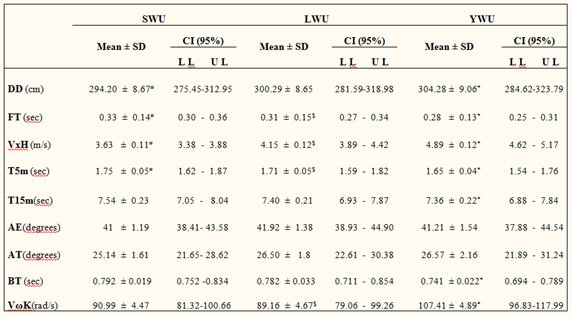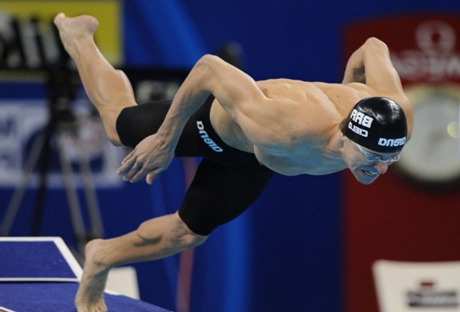Introduction and methodolody:
Swimming start performance is an important component of the swimming race, especially in short events (Burkett et al., 2010). Such relationship has led the interest of some authors for optimizing the take-off parameters of a swimming start, providing specific warm up routines related to Post-activation performance enhancement (PAPE) methods (Benjanuvatra et al., 2007; Cuenca-Fernández et al., 2015). PAPE improves muscle contractility, in strength and speed, by having previously applied a combination between near maximal loads with an optimal recovery time after such conditioning activity (Cuenca-Fernández et al., 2017). Some studies have confirmed this issue in lower limbs through an assessment of the performance during the recovery period and the results concluded that PAPE benefits are more effective when including a rest period of 6-8 minutes after a submaximal stimulus application (Kilduff et al., 2011; Tillin and Bishop, 2009); when it is applied to trained subjects or individuals with a high proportion of fast fiber because they are considered individuals better prepared or accustomed to overcome the fatigue (Sale 2004); and, when the gesture to cause potentiation is biomechanically similar to the real movement, because the empowerment obtained is more specific and intense in the muscles involved (Esformes et al., 2010).
However, comparisons are not possible if is unknown a value of that state of training. In a study, it was offered the relative force (FREL), as a way of obtaining such categorization. The purpose of that study was twofold. The first aim was to evaluate the relationship between lower limbs FREL values obtained through a Lunge test and performance on a swimming start. The second aim was to evaluate such relationship after the application of two specific PAPE protocols.
A group of 14 swimmers performed a standard warm-up composed of 400m and followed by 3 maximal repetitions of one of the activation protocols showed in Figure 1: the Lunge warm-up (LWU), or the YoYo warm-up (YWU).

Figura 1. Lunge exercise (left) and YoYo exercise (right) simulating the movement of the swimming start performance on the block.
After 8 minutes of rest, all swimmers were tested on a maximum swimming start and the following variables were assessed:
-Dive Distance (DD): (in centimeters).
-Flight time (FT): (in seconds).
-Horizontal Hip Velocity (VxH) [during the flight]: (in meters per seconds).
-Time to 5 meters (T5m).
-Time to 15 meters (T15m).
–Block Time (BT): (in seconds)
-Angle of Take-off (AT): (in degrees).
-Angle of Entry (AE): (in degrees).
–Angular Velocity of Knee Extension (VωK) (rad/s)
Results and Discussion:
Results showed that protocols which included specific PAPE added to the regular warm up achieved better values (Table 1), than obtained after SWU (Cuenca-Fernandez et al., 2014). Specifically, warm up which included the YoYo Squat repetitions (YWU) was showed as intense enough for causing the biggest improvement on performance (Table 1).

Table 1. Mean, standard deviation and confidence interval of spatio-temporal and angular variables in the three different activation protocols (n=14).
Table 2 shows Pearson’s correlation coefficient between baseline FREL values and kinematic measurements of a swimming start after the changes occasioned in performance by PAPE. Kinematic variables of the swimming start were positive correlated with baseline FREL values obtained through the Lunge exercise. T15m was negatively correlated with FREL. This means, individuals with stronger lower limbs performed the swimming start in better conditions than those who showed lower values in strength tests.

Table 2. Pearson’s correlation coefficient between Relative Force values and swimming start variables (n = 14)
These results are in agreement with those showed by Beretic et al., (2013) and West et al., (2011). Swimmers with higher values in FREL after Lunge test achieved a higher VxH during flight (R2 = 0.308, p<0.049), who allowed them to increase their DD (R2 = 0.761, p<0.001) and reducing the T15m (R2 = -0.813, p=0.001).

Figure 2. Regression analysis between Relative Force (Frel) and Horizontal Hip Velocity (VxH).

Figure 3. Regression analysis between Relative Force (Frel) and Dive Distance.

Figure 4. Regression analysis between Relative Force (Frel) and Time to 15m.
However, in the strength test carried out in the study of Beretic et al., (2013), subjects performed isometric strength test with feet in parallel position. Meanwhile, in the study of West et al., (2011), all the trials were performed by a swimming grab start. Thus, it was necessary to present an update in this field in view of an asymmetric feet placement.
When considering the changes occasioned in performance by PAPE, correlations with baseline relative force values were still maintained, or they became even stronger depending on the intensity of the warm up applied, as the case of variable VxH (Table 2). A visual comparison to Figure 1, show an ascending tendency in the line regression after LWU compared with SWU, and even a higher inclination of the regression line after YWU when compared with LWU and SWU. This fact showed two things; Firstly, the more FREL, the higher the improvement occasioned by PAPE (Tillin & Bishop, 2009). Secondly, the stronger the PAPE applied (Cuenca-Fernandez et al., 2015), the higher effect in swimmers with high level of FREL.
Pratical applications for coaches: The FREL is a reliable factor for correlating the strength of the subjects with performance developed in a specific task such as the swimming start performance. It provides to the coach an easy tool for measuring the state of training of their subjects because it considers the body weight of the subject when mobilizing loads. Most trained individuals were able of performing a swimming start with better guarantees. Subjects with higher values in FREL showed to react better after PAPE application, especially after YWU, which confirms that PAPE effects are bigger the more specific is it applied and the more trained subjects are.
Extended versions of this study:
-Cuenca-Fernández, F., López-Contreras, G., & Arellano, R. (2015). Effect on swimming start performance of two types of activation protocols: lunge and YoYo squat. The Journal of Strength & Conditioning Research, 29(3), 647-655. Doi: 10.1519/JSC.0000000000000696
-Cuenca-Fernández, F., Taladriz, S., López-Contreras, G., de la de la Fuente, B., Argüelles, J., & Arellano, R. (2015). RELATIVE FORCE AND PAP IN SWIMMING START PERFORMANCE. In ISBS-Conference Proceedings Archive. Retrieved from: https://ojs.ub.uni-konstanz.de/cpa/article/view/6536
Acknowledgements
This study was supported by the Spanish Research Agency and the European Regional Development Fund (ERDF) under grant: PGC2018-102116-B-I00 “SWIM II: Water-specific innovative measures: applied to performance improvement”.
References
- Benjanuvatra, N, Edmunds, K, Blanksby, K. Jumping ability and Swimming Grab-Start performance in Elite and Recreational swimmers. Int J. Aquatic Res Educ 7 (1): 231-241, 2007.
- Beretic, I., Durovic, M., Okicic, T., & Dopsaj, M. (2013). Relations between Lower Body Isometric Muscle Force Characteristics and Start Performance in Elite Male Sprint Swimmers. Journal of Sports Science and Medicine, 12(4), 639-645.
- Burkett, B, Mellifont, R, Mason, B. The influence of swimming start components for selected Olympic and Paralympic swimmers. J Appl Biomech 26(2): 134-141, 2010.
- Cuenca-Fernández, F., Smith, I. C., Jordan, M. J., MacIntosh, B. R., López-Contreras, G., Arellano, R., & Herzog, W. (2017). Nonlocalized postactivation performance enhancement (PAPE) effects in trained athletes: a pilot study. Applied Physiology, Nutrition, and Metabolism, 42(10), 1122-1125.
- Esformes, JI, Cameron, N, Bampouras, M. Postactivation potentiation following different modes of J. Strength Cond. Res 24(7): 1911-1916, 2010.
- Kilduff, L. P., Cunningham, D. J., Owen, N. J., West, D. J., Bracken, R. M., & Cook, C. J. (2011). Effect of postactivation potentiation on swimming starts in international sprint swimmers. J Strength Cond Res, 25(9), 2418-2423. doi: 10.1519/JSC.0b013e318201bf7a
- Tillin, N. A., & Bishop, D. (2009). Factors modulating postactivation potentiation and its effect on subsequent explosive activities. Sports Med, 39(2), 147-166.
- Sale, D. (2004). Postactivation potentiation: role in performance. British Journal of Sports Medicine, 38(4), 386-387.
- West, D. J., Owen, N. J., Cunningham, D. J., Cook, C. J., & Kilduff, L. P. (2011). Strength and Power Predictors of Swimming Starts in International Sprint Swimmers. Journal of Strength and Conditioning Research, 25(4), 950-955.

Leave a Reply